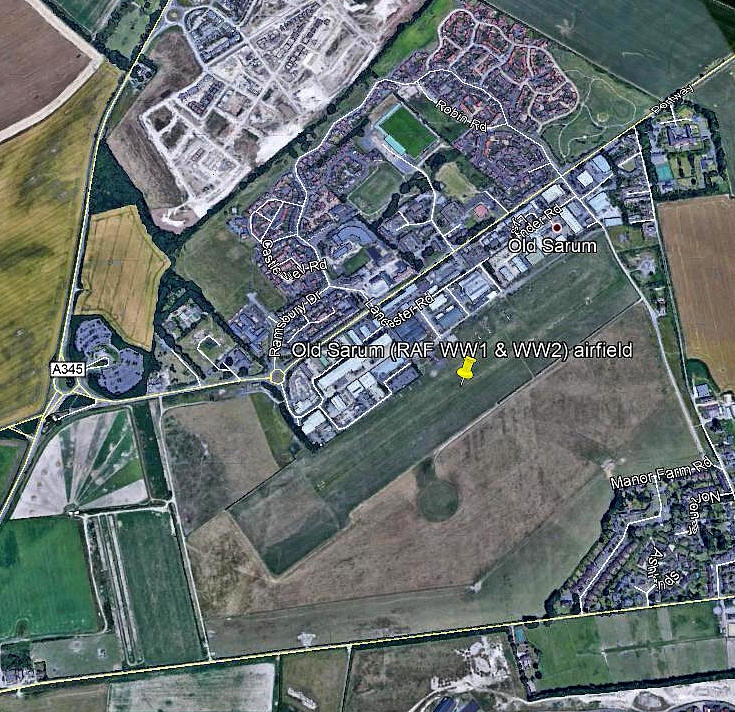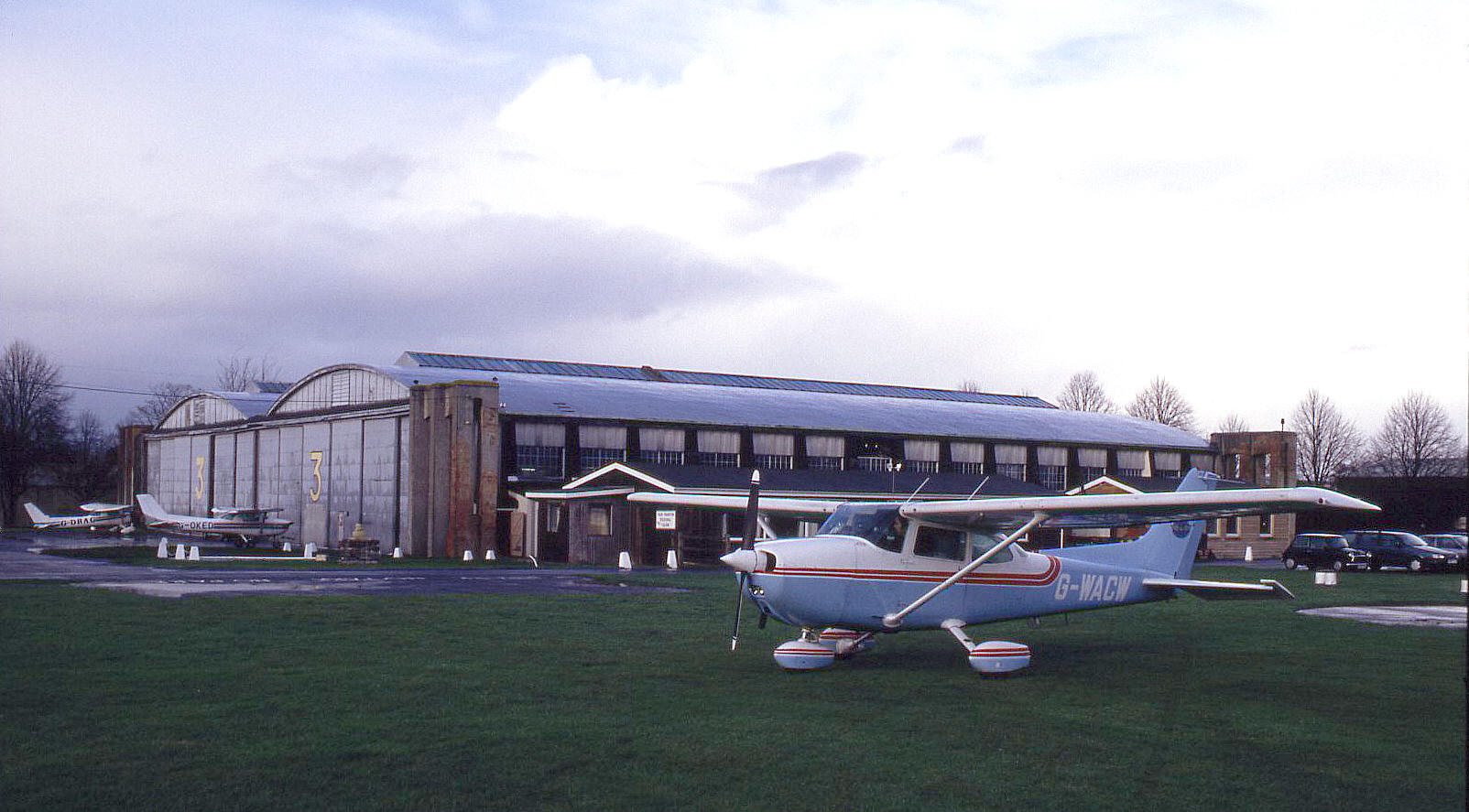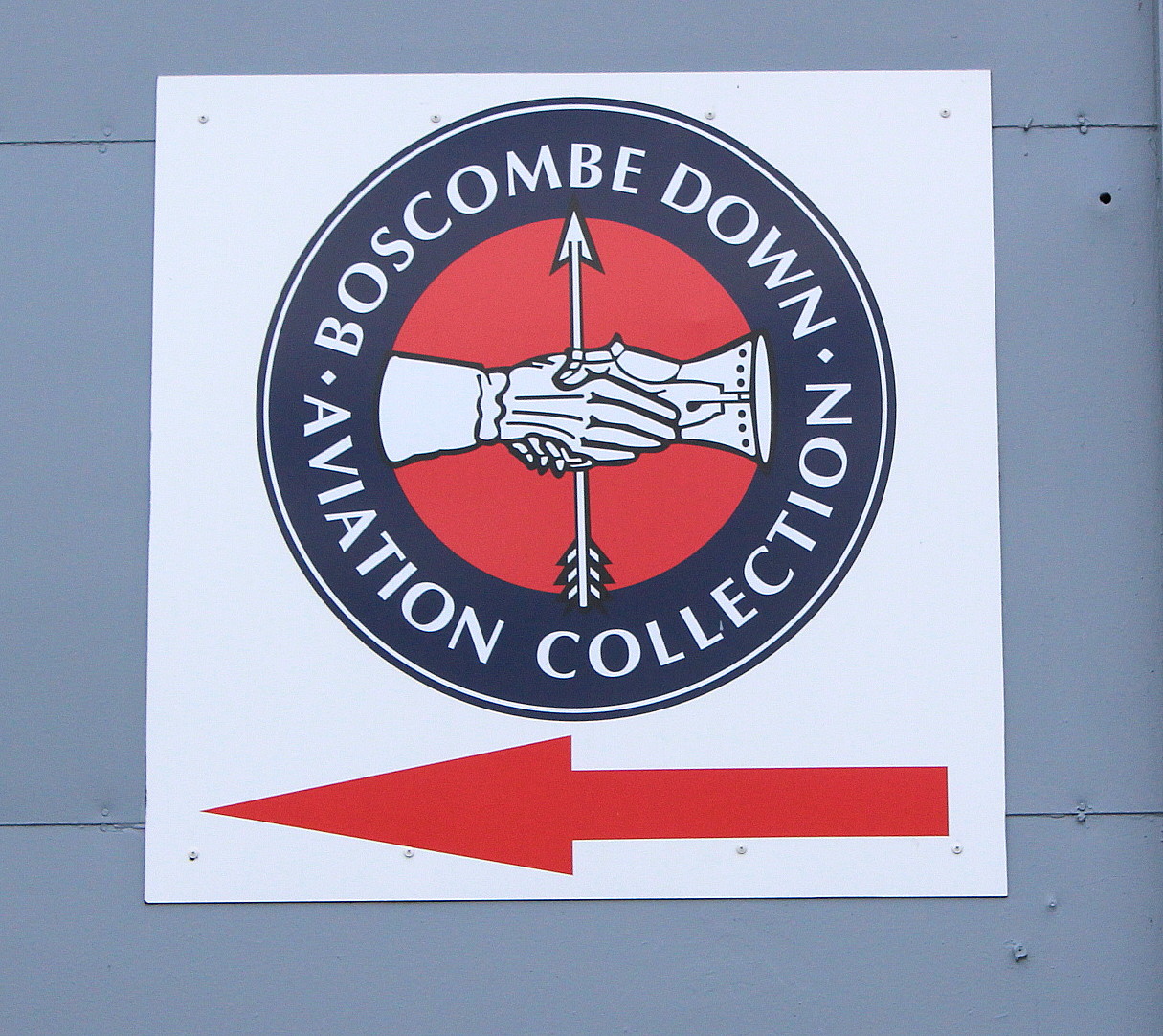Old Sarum
OLD SARUM: Military aerodrome later civil aerodrome (also known as FORD FARM in WW1)
Note: This picture obtained from Google Earth ©
All other pictures by the author unless specified.
Operated by: 1982: Edgely Aircraft
1984/1990: Brooklands Aerospace Group plc
2000: Megastream Ltd
Military users: WW1: RFC/RAF Training Squadron Station and Training Depot Station
98 & 103 Sqdns (Airco DH.9s)
1919 to 1939: RAF School of Army Co-operation
(Hawker Hectors & Westland Lysanders)
225 Sqdn (Westland Lysanders)
529 Sqdn (Cierva C-30A Rota 1 autogyros)
WW2: RAF Fighter Command 70 Group
RAF School of Army Co-operation
OTU [Operational Training Unit] (Hawker Hectors & Westland Lysanders)
Post 1945: RN Air Section (School of Land/Air Warfare)
Gliding: Listed as operating in 1975 to 1992 only? (Military then civil?)
Dorset Gliding Club from 1981 to 1992
Location: E of A345, 2 nm NNE of Salisbury
Flying club/schools: Post 1945: Old Sarum Flying Club, Shadow Flight Centre
1959 ‘snapshot’. Bustard Flying Club (Also at BOSCOMBE DOWN), PFA Group 172 (also at REDHILL & THRUXTON)
Maintenance: Post 1945: Old Sarum Engineering
Manufacturing: Post 1945: Edgely Aircraft
Period of operation: Military: 1917 to 1979 (RAF 1917 to 1971 – Army 1971 to 1979)
Reopened for GA use in 1982 and still very much operational until the 31st October 2019
Site area: WW1: 182 acres 914 x 823
Note: This map is reproduced with the kind permission of Pooleys Flight Equipment. Copyright Robert Pooley 2014
Runway: WW2: NE/SW 1097 grass
1990: 06/24 681x50 grass Gliding strip parallel to, S of 06/24 and similar length
2000: 06/24 781x50 grass
NOTES: It appears that 103 Squadron were the first to operate the Airco DH.9 in December 1917. Developed from the very successful Airco DH.4 the Airco DH.9 was initially a major disappointment mainly due to its virtually useless, underpowered and very unreliable BHP engine which barely yielded 230hp when claimed to have 300hp at the design stage. For example a fully loaded DH.9 could barely reach 15,000ft, against the 22,000ft of the DH.4 it was supposed to replace.
It appears that for some reason the aerodrome was closed from 1920 to 1921?
In the early to mid 1930s No.16 squadron operated Armstrong Whitworth Atlas types.
A MICHAEL T HOLDER GALLERY
On the 21st August 1929, Sir Alan Cobham arrived to promote his Municipal Aerodrome Campaign. Starting in May and ending in October, his original plan was to visit 107 venues. After a couple of crashes and other setbacks, he eventually managed to visit 96, which was of course a quite magnificent achievement. The aircraft he mostly used was the ten-seater de Havilland DH61 'Giant Moth' G-AAEV, named 'Youth of Britain'.
Although the timing of the daily schedule varied a bit during the day, Cobham invariably arrived at around 11.00. He then took the local dignitaries around the local area, then selected school children, the cost of which was met by a then anonymous donor, now known as being Lord Wakefield of Castrol Oil fame. Afterwards he took fare paying passengers for flights, usually until dusk, presumably to off-set the costs of the tour.
At around lunchtime a grand event was arranged at the town hall, or a posh hotel, when Cobham would extol the benefits of the town having an aerodrome/airport to meet modern needs. And he was quite correct in having this vision of course. And indeed, many such facilities were constructed before WW2.
Note: The newspaper article was published in the Wiltshire Times and Trowbridge Advertiser on the 24th August 1929.
THE SCHOOL OF ARMY CO-OPERATION
In his excellent book Spitfire Voices Dilip Sarkar tells us this: "It is a fact that between the wars strategic thinking always supported the view that 'the bomber will always get through'. Fighters were considered of limited value, even for defence, and yet the role of army co-operation flying was considered essential. Fighter Command was actually responsible for training pilots to serve in such squadrons, and instruction was provided at the School of Army Co-operation at Old Sarum in Wiltshire, which had existed since the Great War."
"In 1939, the object was to train replacement crews for tactical reconnaissance squadrons flying the twin-engined Bristol Blenheim. Shortly after the war started, many of these units were sent to France with the BEF's Air Component. Anticipating the likely need for replacement pilots, a reserve pool was added to the school at Old Sarum, the combined output of which was seventy-two pilots, thirty-seven observers, and seventy-two air gunners on a six-week course which included forty hours of flying."
"The school's aircraft establishment was increased to twelve Lysanders, twelve Hectors, twelve Ansons and fifteen Blenheims. The site at Old Sarum consequently became too small, and the school was therefore divided: single-engine types remaining there while twins went to Andover. Old Sarum trained twenty pilots and twenty air gunners per fortnight on a fortnightly course, while Andover's course remained six weeks."
SOMETHING TO LOOK INTO?
Although apparently closing in 1975 I was intrigued to find that in 1977 one source still listed the aerodrome as being a military/ministry site, and that Cessna 150D G-AWAX, Luton L.A.4a Minor G-AYDY and Jodel DR.1050/MI Sicile Record, operated by the Bustard Flying Club, were based here.
In 1985 it’s use was described as “Aircraft Industry” and used by Edgley Aircraft.
Picture from Light Aviation magazine.
THE SKYLARK
I find it wonderful in this day and age, that an aeroplane such as this can be designed and built, in this case by Nigel Townsend aided by his father Gerald. It really is inspiring, and the Skylark first flew on the 12th March 2016 - and flew very well.
OLD SARUM FLYING CLUB
In 2006 the Old Sarum Flying Club were offering a unique mix of aircraft, (in the UK at least), to train on. Ranging from two Bulldogs, five Cessna 150/152s, a Cessna 172 (the ‘classic’ all time GA aeroplane of course*), a Cessna Reims Rocket, a Champion Citabria, a Piper PA-18 Super Cub, two Piper PA-28-161s, a Piper PA-28R-200 and a Piper PA-34 Seneca. Plus a Robin DR400-160 and, a Sky Arrow (!) What a line up!
Despite a rather dodgy past, with closure often pending, this classic aerodrome has in recent years gone from strength to strength and its future now seems assured. Busy and bustling in the 21st century this lovely aerodrome is a delight to visit.
* The ‘spam-can’ Cessna 172 has adopted me. Throughout my travels I have flown at least seventy examples ranging from very old to very new. Often the only aircraft available on the apron to go flying in with very short notice. None have let me down. To fly one is similar to driving a 1960s Austin Cambridge or Ford Consul, but where could you hire one of those to drive today? A much misunderstood aeroplane, which, if lightly laden, (two POB and half tanks), is actually a very good short strip performer. Probably the best of the few mass produced US ‘spam-can’ types which can safely attempt short strip operations? (400 metre strips with generous allowances). On the other hand, a Reims-Rocket 172 in the right hands, with just a pilot on board can accomplish quite extraordinary STOL performance!
PERSONAL MEMORIES
My first visit by air to OLD SARUM was in the Cessna 172 G-WACW in December 1994 via the low level route from THRUXTON. We then flew on to COMPTON ABBASS. My second visit was on the 5th May 2008, in the Cessna 172 G-BDNU. My very good friend Gordon Brown flew 'November Uniform' in from DUNKESWELL and I then took off for CHILTERN PARK.
AN ACT OF UTTER VANDALISM?
It was announced that on the 31st October 2019 OLD SARUM would be closed for good. To be trashed by the utter scum of humanity, unthinking and uncaring property developers - not that I am biased of course. Will they next be looking at demolishing nearby Salisbury cathedral to grab that prime real estate?
But, on the 1st November I found on the inter-web a faint glimmer of hope that all may not be lost?
In December 2021 I was kindly contacted by Mr Steve Gerrard who had just visited the site. There were two aircraft there, one without an engine and looking in a sad state. The other looked in much better condition. The Boscombe Down museum was still there, but looking closed. On a happier note, in the 1970s he was gliding here with the Air Training Corps who were using Slingsby T21s and T31s. He gained his Glider Pilots License aged 16.
THINGS SEEM TO BE LOOKING UP?
On a quick visit on the 2nd June 2024, the main activity was parachuting - and - they were busy. A couple of GA aircraft had visited whilst I was there and a King Air was parked.
Notes: M-POWR is a Beech C90A King Air. G-SCOL is a Gippsland GA8 Airvan and has been registered to Parachuting Aircraft Ltd here since 06.04.2011. The Cessna 208B Grand Caravan, N240GS, was doing all the work at that time. The parachuting drop zone is at the western end of the site.
THE BOSCOMBE DOWN AVIATION COLLECTION
Their website in 2024 states they are open six days a week from 10.00 to 17.00. Closed on Mondays except Bank Holidays. I had arrived too late to make a hangar visit, so, definitely on my wish list for a future visit.
Andrew
This comment was written on: 2019-10-04 13:57:44I visited Old Sarum last week. There were hardly any aircraft to see, about 6. The chap who runs the museum told me that they have until November to find alternative arrangements and unless somebody can come up with a solution, the airfield will be closed to flying although the museum remains open as it is completely separate and is well worth a visit. My understanding is that Thruxton is the likely destination for aircraft that have moved.
We'd love to hear from you, so please scroll down to leave a comment!
Leave a comment ...
Copyright (c) UK Airfield Guide

































